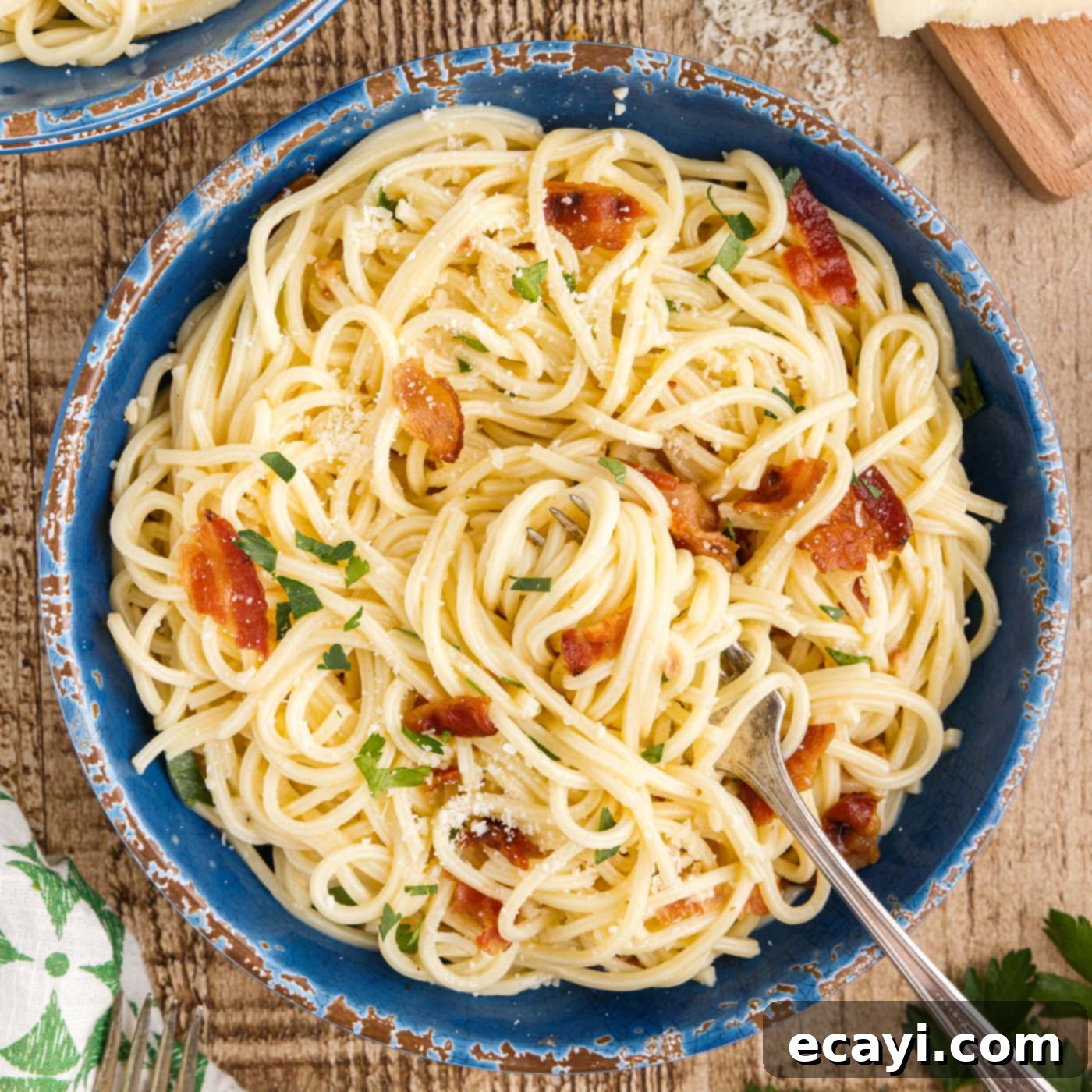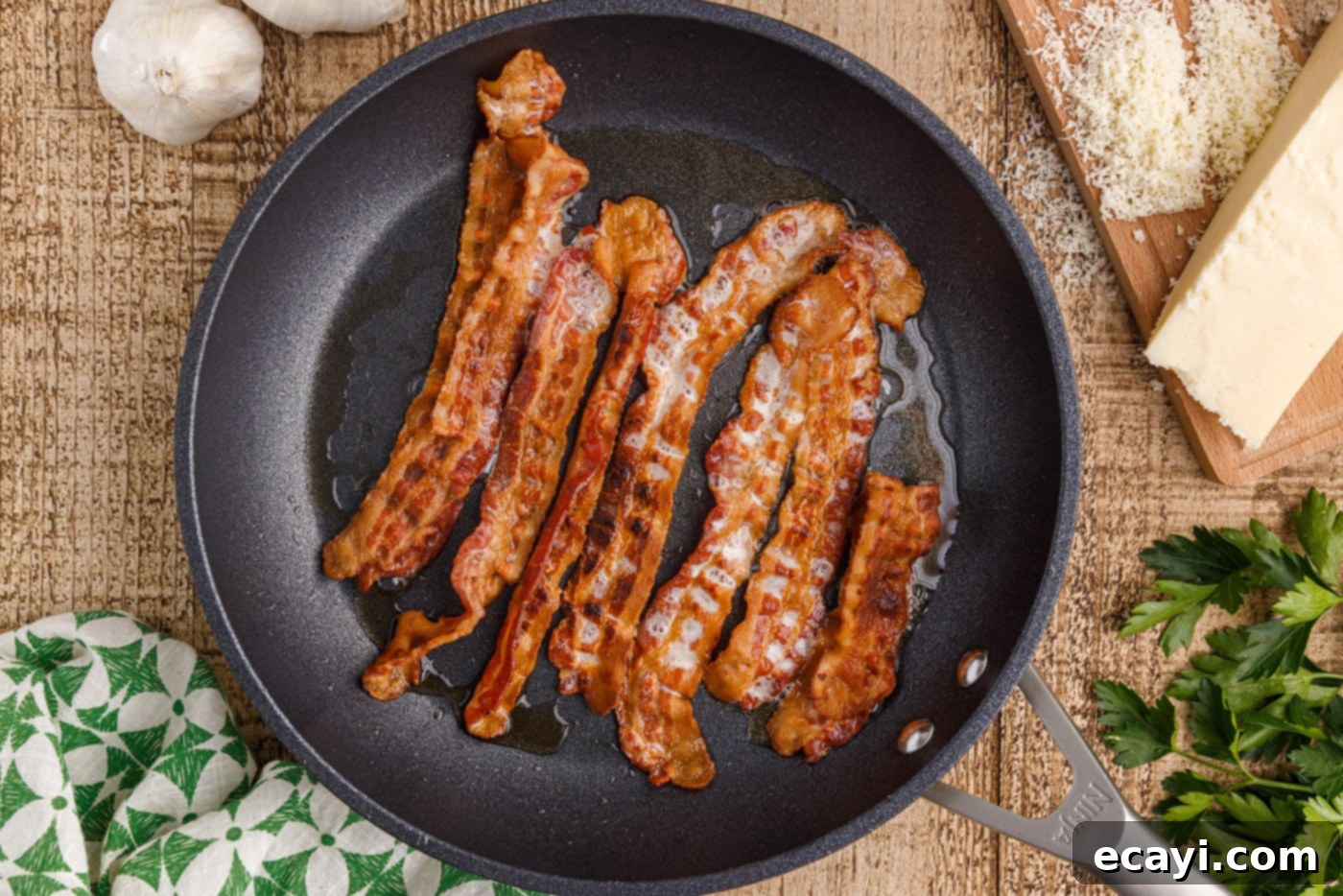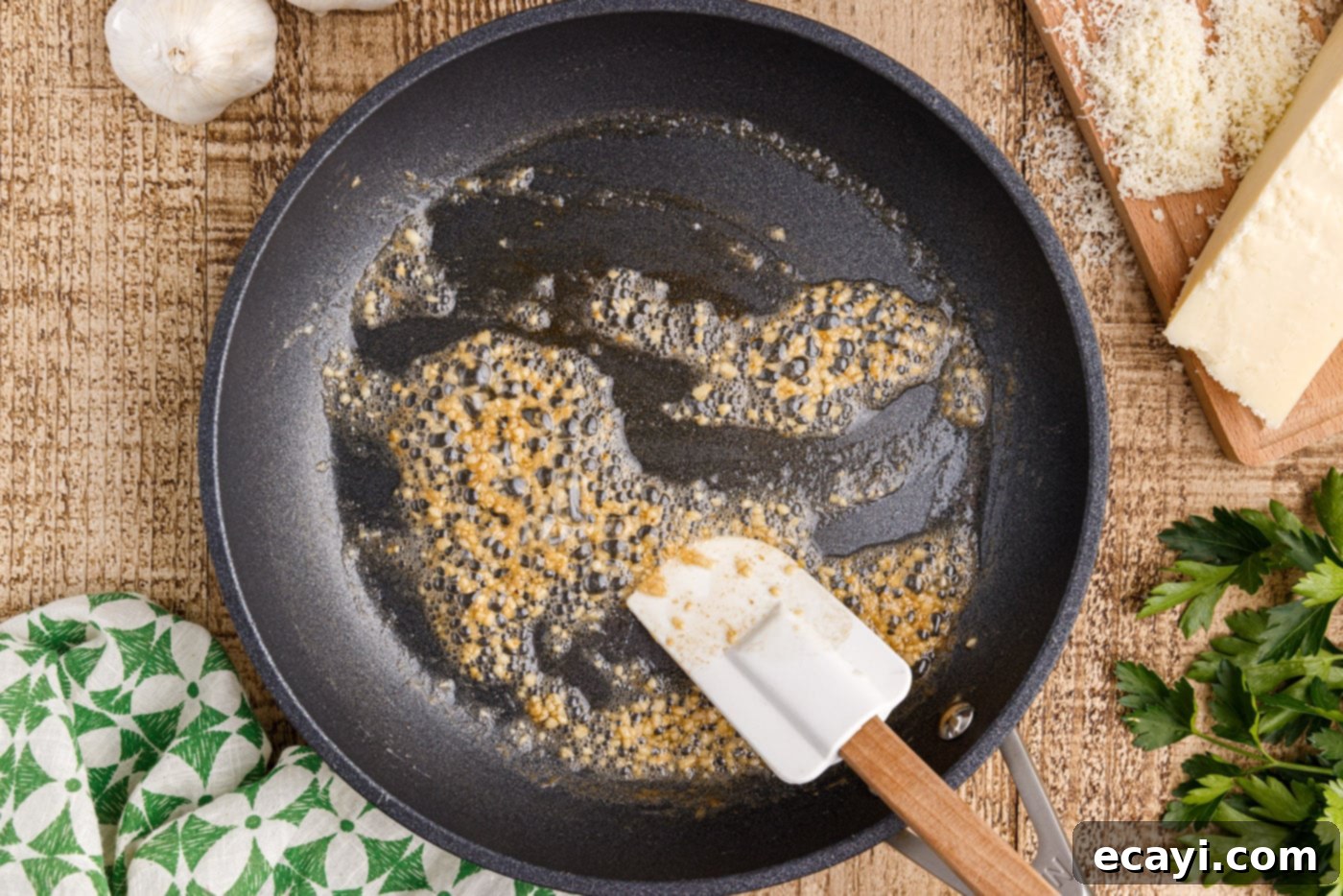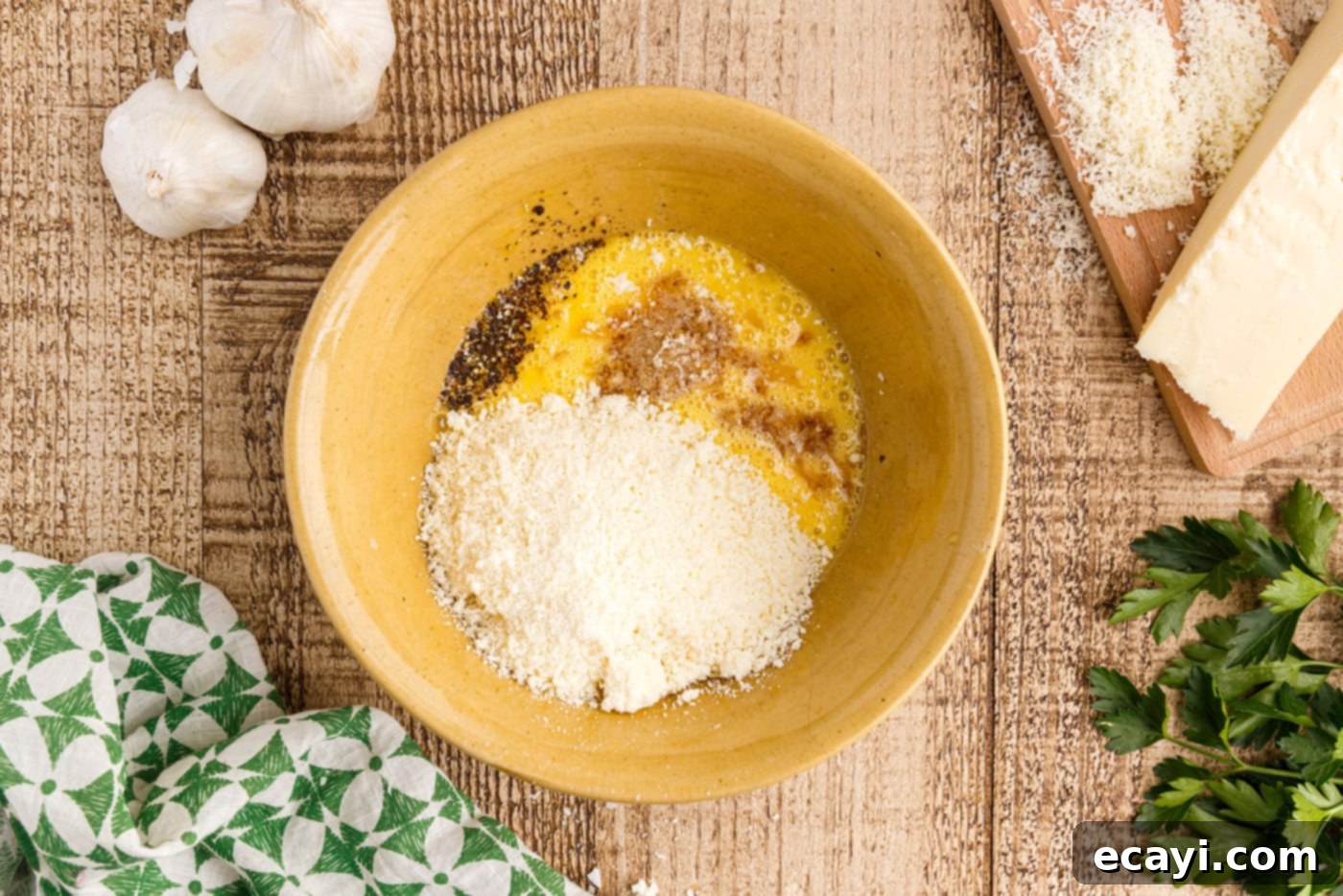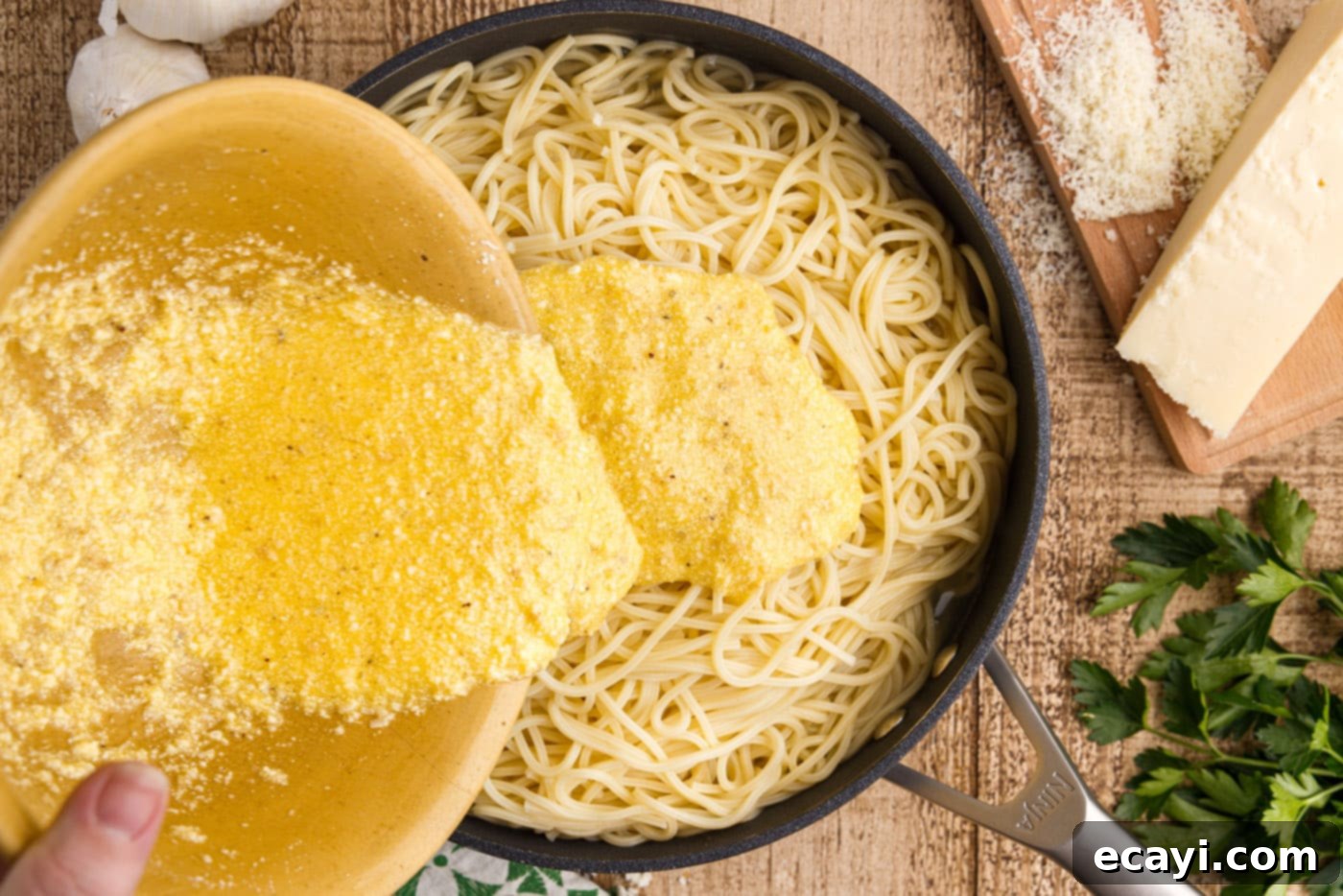Easy 5-Ingredient Bacon Carbonara: Your Ultimate Guide to a Quick & Creamy Italian Classic
Indulge in a truly delightful and incredibly simple culinary experience with our 5-ingredient pasta carbonara recipe. This isn’t just any pasta dish; it’s a celebration of flavor and speed, combining crispy crumbled bacon with perfectly cooked spaghetti, all enveloped in a rich, velvety cheese sauce. Forget takeout – this creamy, comforting Italian masterpiece can be on your table in under 25 minutes, making it the ideal solution for busy weeknights when you crave something extraordinary without the fuss. Our easy carbonara recipe offers all the authentic taste with a modern, approachable twist, proving that exceptional flavor doesn’t require a long list of ingredients or hours in the kitchen.
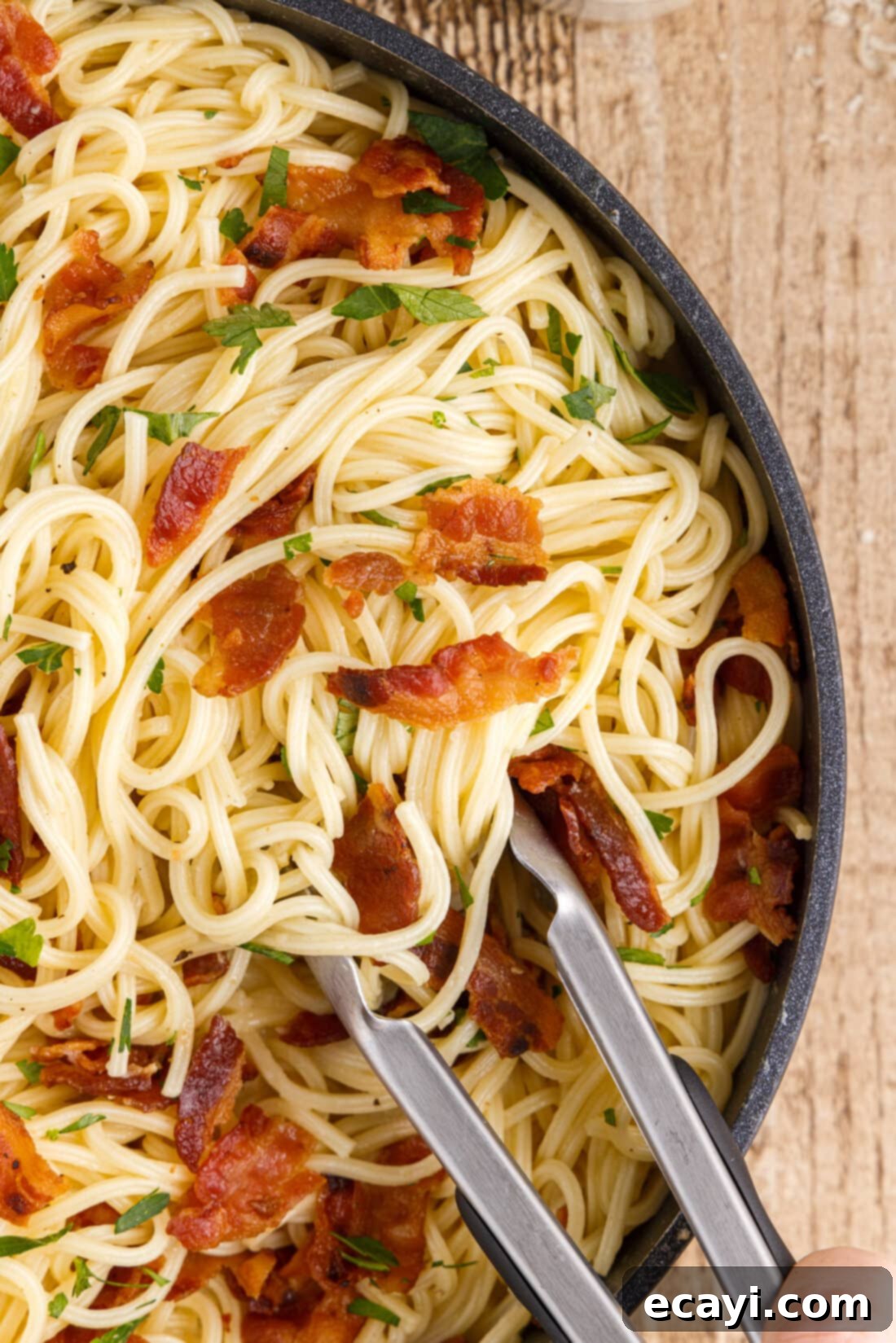
Why This Easy Bacon Carbonara Recipe Will Be Your New Favorite
Pasta Carbonara is a timeless Roman dish renowned for its simplicity and depth of flavor, traditionally showcasing cured pork. While classic recipes often feature guanciale (Italian cured pork jowl) or pancetta (salt-cured pork belly), our rendition thoughtfully adapts the classic to make it even more accessible without sacrificing any of its soul. We’ve expertly swapped these specialty meats for readily available, smoky bacon, transforming it into what we affectionately call “bacon spaghetti” in our home. This substitution not only makes the dish incredibly convenient but also introduces a familiar smoky richness that pairs beautifully with the pasta and cheese sauce.
But the true star of this easy carbonara recipe, in my humble opinion, is the luscious, creamy sauce. What’s truly remarkable is that this luxurious texture and vibrant flavor are achieved without a single drop of actual cream or butter! Instead, it’s a brilliant alchemy of fresh eggs, finely grated hard Italian cheese (Pecorino Romano or Parmesan, or a delightful blend), and the magical starchy water reserved from cooking your spaghetti. These humble ingredients, when combined with care and the residual heat of the hot pasta, emulsify into a silken coating that binds all elements together into a harmonious symphony of taste and texture. This method is the hallmark of authentic carbonara, delivering a dish that is both deeply satisfying and surprisingly light, allowing the quality of each core ingredient to shine through.
Beyond its incredible taste, what sets this bacon carbonara apart is its unparalleled speed and simplicity. With just 5 core ingredients (excluding salt and pepper, which are kitchen staples), and a total prep-to-plate time of under 25 minutes, it’s a lifesaver for those busy weeknights. Imagine coming home after a long day and whipping up a gourmet-quality meal faster than you can order takeout. This quick carbonara isn’t just fast; it’s a flavorful and hearty dish that feeds the whole family. Serve this delightful pasta dish with a side of warm, homemade parmesan garlic rolls, a crisp green salad, or some roasted vegetables to round out a perfect, easy Italian meal.
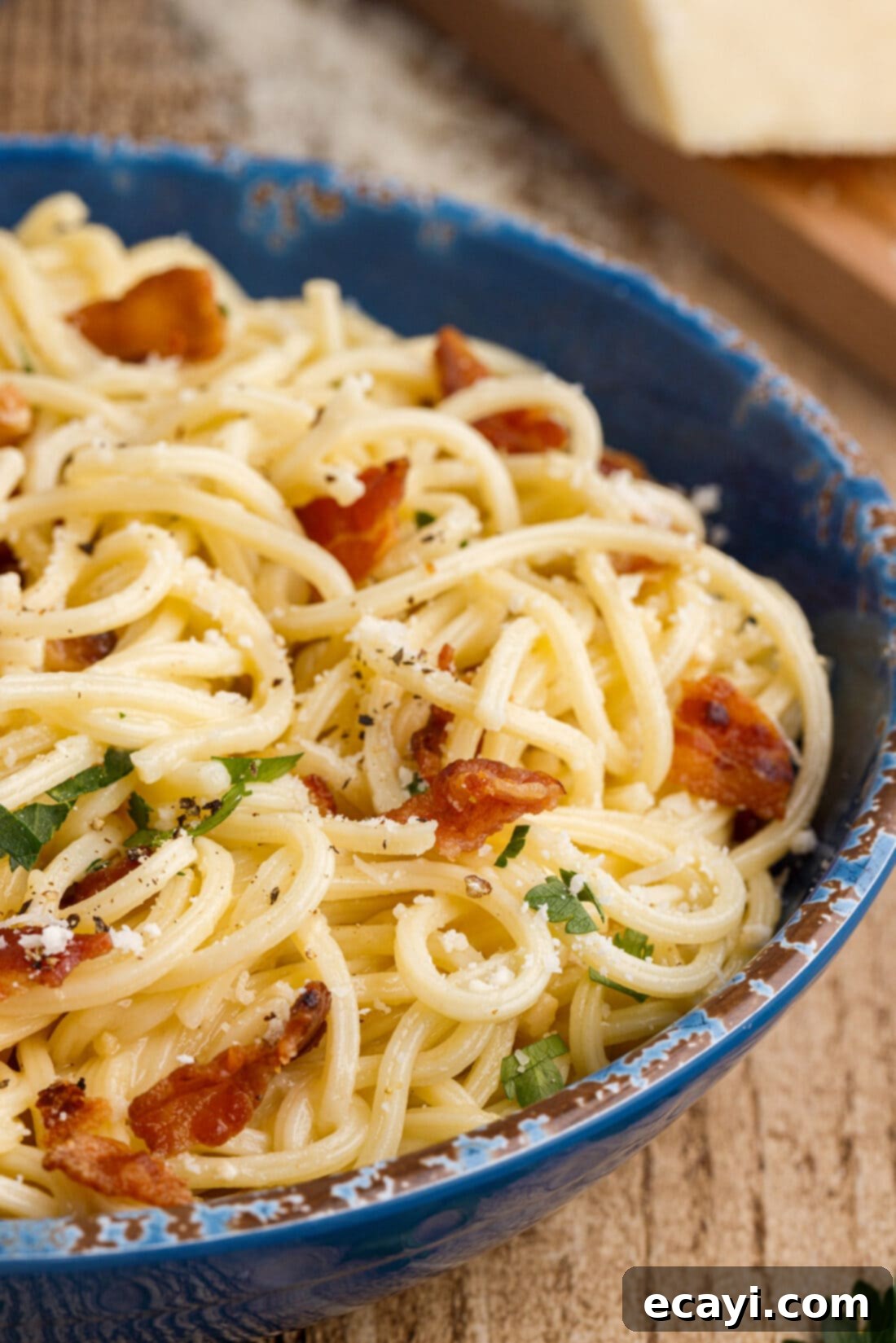
Essential Ingredients for Your 5-Ingredient Carbonara
Crafting the perfect pasta carbonara starts with a handful of quality ingredients. This recipe is celebrated for its minimalism, relying on simple components to create maximum flavor and a truly authentic taste experience. While we highlight the core 5 ingredients, remember that a dash of salt and pepper are always essential for seasoning to taste. The beauty of this dish lies in how a few excellent elements can combine to create something extraordinary. For a complete list of precise measurements and detailed step-by-step instructions, refer to the printable recipe card at the very end of this post.
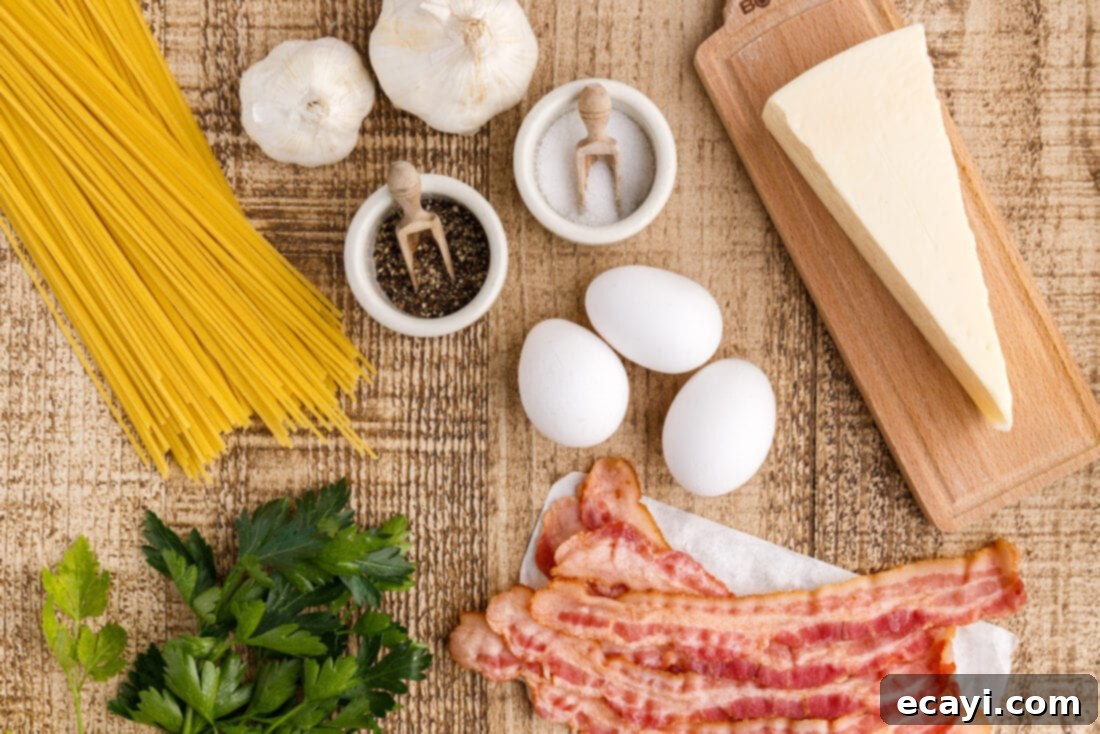
Ingredient Spotlight: Tips & Smart Substitutions for the Best Carbonara
Each ingredient in carbonara plays a crucial role in achieving that signature taste and texture. Understanding these roles, along with potential substitutions and expert tips, will help you master this delightful dish every time you make it.
The Creamy Carbonara Sauce (No Cream Involved!)
The magic of pasta carbonara lies in its rich, cheesy sauce, which, surprisingly to many, contains no actual cream or butter! The luscious emulsion is created by combining beaten eggs, finely grated hard Italian cheese, and a splash of hot, starchy pasta water. The heat from the pasta and the reserved water gently cooks the eggs and melts the cheese, forming a glossy, luxurious coating that clings beautifully to every strand of spaghetti. For the cheese, you have excellent options:
- Pecorino Romano: This traditional Roman cheese offers a sharp, salty, and pungent flavor that is quintessential to authentic carbonara. It adds a bold character.
- Parmesan Cheese (Parmigiano Reggiano): A slightly milder, nuttier, and fruitier alternative. It’s widely available and still delivers fantastic results for a creamy, savory sauce.
- A Mixture: For the best of both worlds, and often a more balanced flavor profile, use a 50/50 blend of Pecorino Romano and Parmesan. This combines the sharpness with a milder, more complex depth.
Tip for Sauce Consistency: You can adjust the amount of starchy pasta water to control the richness and volume of your carbonara sauce. Start with 1 cup of the reserved pasta water and add more gradually (up to 2 cups as suggested in the recipe) until you reach your desired consistency. For a thicker, more clinging sauce, use less water. If you prefer a more generous sauce, consider increasing the number of eggs and the amount of cheese proportionally, rather than just adding more water, to maintain flavor intensity. Critically, ensure your eggs are at room temperature to prevent them from scrambling when they hit the hot pasta – this is a key step for achieving a perfectly smooth, emulsified sauce.
The Meat: Bacon for a Delicious Twist
While classic Roman carbonara often features guanciale or pancetta, our recipe shines with accessible and delicious bacon. This makes our bacon carbonara a fantastic choice for everyday cooking without compromising on flavor or that essential salty, fatty component.
- Bacon: Choose good quality, thick-cut bacon for the best flavor and texture. The smoky, salty notes of bacon render beautifully, providing a flavorful fat that is integral to the sauce. This rendered fat is liquid gold, infusing the garlic and eventually the entire dish with a depth of flavor. You can cook the bacon either as whole strips and then crumble it once crisp, or chop it into small pieces (lardons) before cooking to achieve a more uniform texture and faster crisping.
- Pre-cooked Bacon: For an even faster dinner, pre-cooked bacon can be used. However, it still benefits from a quick pan-fry to crisp it up and, crucially, to release a tablespoon or so of flavorful fat, which is essential for sautéing the garlic and enhancing the sauce’s overall richness.
- Guanciale or Pancetta (Optional): If you’re looking for a more traditional or adventurous experience and can find them at specialty delis, guanciale or pancetta can be used. Guanciale offers a richer, more nuanced flavor due to its unique curing process, while pancetta provides a milder, salty depth. Prepare them in the same way you would bacon – cook until crispy, reserving the rendered fat for the sauce.
The Pasta: Spaghetti’s Perfect Embrace
Spaghetti is the quintessential choice for carbonara, with its long strands perfectly designed to be coated in the creamy sauce, allowing for that satisfying twirl on your fork. However, other pasta shapes can also work beautifully, depending on your preference:
- Spaghetti: The classic choice, offering an ideal surface for the rich sauce to cling to.
- Bucatini: A slightly thicker, hollow spaghetti, which allows the creamy sauce to get inside, providing a delightful textural experience with every bite.
- Rigatoni or Penne: Shorter, tubular pasta shapes are excellent for catching bits of crispy bacon and a generous amount of sauce, providing a heartier and perhaps easier-to-eat bite.
Regardless of the shape, cooking your pasta al dente is absolutely key. This ensures it holds its structure and provides a satisfying chew, preventing a mushy texture in the final dish. The al dente bite also provides the necessary starch for the sauce to properly emulsify.
Aromatic Garlic: Minced garlic adds a subtle warmth and aromatic base to the dish. Sautéing it briefly in the rendered bacon fat infuses the entire dish with its irresistible fragrance, complementing the rich flavors of the meat and cheese without overpowering them. It’s a small but mighty flavor contributor.
Step-by-Step: Crafting Your Perfect Pasta Carbonara
These step-by-step photos and detailed instructions are here to help you visualize how to make this incredibly easy bacon carbonara recipe. For a quick reference or to print, you can Jump to Recipe to get the printable version of this recipe, complete with precise measurements and instructions at the bottom of the page.
- Cook the Spaghetti: Bring a large pot of generously salted water to a rolling boil. Add the spaghetti and cook according to package directions until al dente – firm to the bite but cooked through. This typically takes 8-10 minutes. Before draining, make sure to reserve at least two cups of the hot, starchy pasta water. This water is crucial for creating the creamy, emulsified sauce! Drain the pasta thoroughly after reserving the water.
- Crisp the Bacon: While the pasta cooks, heat a large skillet over medium heat. Add the bacon and cook until it is beautifully crisp and golden brown. This usually takes about 5-8 minutes, depending on the thickness of your bacon. Once crisp, remove the bacon from the pan using a slotted spoon, allowing most of the rendered fat to remain in the skillet. Crumble the bacon into small pieces and set aside. Do not clean the skillet, as the remaining bacon grease is essential for the next step and for flavoring your carbonara sauce.

- Sauté the Garlic: With the flavorful bacon grease still in the skillet, add the minced garlic. Sauté for about 30-60 seconds over medium heat, just until it becomes fragrant and lightly golden. Be careful not to burn the garlic, as it can turn bitter very quickly, which would negatively impact your pasta carbonara. Transfer the sautéed garlic and about one tablespoon of the flavorful bacon grease to a medium mixing bowl.

- Prepare the Egg and Cheese Mixture: Into the same mixing bowl with the garlic and bacon grease, add the room temperature eggs, 1/2 teaspoon of freshly ground black pepper, and 1 cup of your finely grated Parmesan or Pecorino Romano cheese. Whisk vigorously until all ingredients are well combined and the mixture is smooth and slightly pale. This forms the essential base of your luscious carbonara sauce.

- Combine and Emulsify: Immediately transfer the hot, drained pasta into the large skillet (or a large serving bowl if you prefer). Quickly pour in about 1 cup of the hot reserved pasta water, followed by the egg and cheese mixture. Crucially, toss everything together vigorously and continuously using tongs or a large spoon. This motion is key to ensuring the pasta is thoroughly coated and the ingredients emulsify. The residual heat from the piping hot pasta and the starchy pasta water will gently cook the eggs and melt the cheese, creating a thick, creamy, and beautifully emulsified sauce without scrambling the eggs. Continue tossing for about 5 minutes, allowing the starches in the pasta to further thicken the sauce to optimal consistency.

- Finish and Serve: Stir in the crumbled, crispy bacon into the pasta, distributing it evenly. Garnish generously with freshly chopped parsley and an extra sprinkle of grated Parmesan cheese, if desired. Serve your quick and creamy bacon carbonara immediately, while it’s still warm and steamy, to enjoy the sauce at its optimal texture and flavor. This dish is best enjoyed right off the stove!
Frequently Asked Questions & Expert Tips for Perfect Carbonara
While carbonara is truly best enjoyed fresh, leftovers can be stored in an air-tight container in the refrigerator for up to 3 days. For the best quality and texture, we strongly recommend consuming it within 24 hours, as the sauce tends to firm up significantly. When reheating, gently warm it in the microwave with a damp paper towel placed over the top to help retain moisture and prevent it from drying out. The sauce tends to be absorbed by the pasta and thicken upon refrigeration. To loosen it up during reheating, you can add a tiny splash of water or, even better, a spoonful of warm chicken broth or extra pasta water (if you have any left) to help revive its creamy texture without significantly diluting the flavor.
Several factors can lead to a clumpy or scrambled carbonara sauce, but the most common culprits are eggs that are too cold or pasta that isn’t hot enough, causing uneven cooking of the egg. Always ensure your eggs are at room temperature – this is crucial for a smooth emulsion and prevents them from seizing. Additionally, you must work quickly once the hot pasta and pasta water are added to the egg and cheese mixture. Continuous and vigorous tossing helps to evenly distribute the heat, allowing the eggs to cook gently and thicken the sauce without curdling. If the pan itself is too hot or if you apply direct heat after combining the sauce, the eggs will scramble instantly. The residual heat from the pasta and reserved pasta water is the only heat source needed to create the perfect creamy texture; no additional stovetop cooking should occur after adding the egg mixture.
Absolutely, using pasteurized eggs is an excellent and safe option, especially if you have concerns about consuming partially cooked or “raw” eggs. Those who are pregnant, elderly, immunocompromised, or serving carbonara to young children may prefer this choice for peace of mind. Pasteurized eggs undergo a gentle heating process that kills off bacteria like salmonella, significantly reducing food safety risks, yet they remain in liquid form, perfect for creating a smooth, creamy sauce in this recipe. You can usually find pasteurized eggs alongside regular eggs in most grocery stores; simply look for “pasteurized” clearly labeled on the carton.
While traditional carbonara is minimalist, many home cooks enjoy adding vegetables for extra flavor, color, and nutritional boost. Popular additions that complement the creamy sauce and salty bacon include sweet green peas (fresh or frozen, added directly to the pasta water during the last minute of cooking), thinly sliced sautéed mushrooms, or blanched asparagus tips. These additions can be folded in with the bacon just before serving. This is a great way to personalize your 5-ingredient carbonara and make it even more wholesome and varied.
The ultimate secret to an ultra-creamy, non-scrambled carbonara lies in rapid emulsification and meticulous temperature control. First and foremost, always use room temperature eggs; cold eggs are more likely to seize. Second, ensure your pasta is piping hot when it’s tossed with the egg and cheese mixture – the heat from the pasta is precisely what cooks the eggs gently. Third, the starchy pasta water is your best friend; its starch content helps thicken and bind the sauce components into a cohesive, velvety consistency. And finally, constant and vigorous tossing is essential! Don’t let the pasta sit; keep it moving with tongs to evenly distribute the heat and prevent the eggs from cooking unevenly or scrambling. This constant motion creates a beautiful, homogenous sauce.
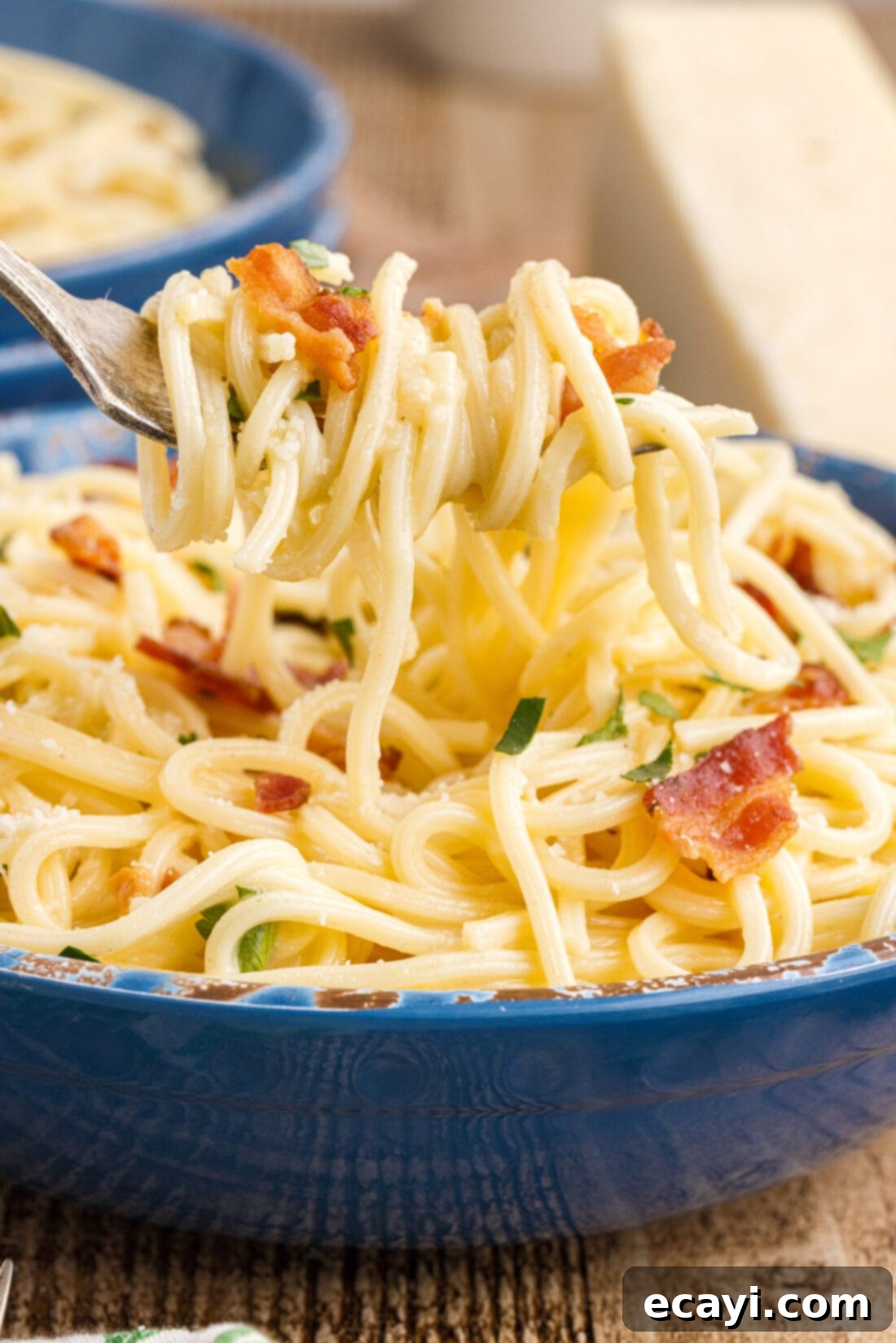
Elevate Your Carbonara: Perfect Serving Suggestions
This easy bacon carbonara is a complete meal on its own, a hearty and satisfying dish that requires little else. However, a few thoughtful additions can truly elevate the dining experience. For a touch of freshness and vibrant color, top your steaming hot pasta with an additional sprinkle of freshly grated Parmesan or Pecorino Romano cheese and a generous scattering of finely chopped fresh parsley. The herbaceous notes of parsley beautifully cut through the richness of the sauce, adding a lovely counterpoint. Serve this quick dinner masterpiece warm and steamy alongside a crisp, lightly dressed green salad for a refreshing contrast, or with crusty artisan bread to soak up every last bit of that exquisite, creamy sauce. For an extra special touch, our recommended homemade parmesan garlic rolls are an absolute winner, providing a soft, savory companion to the rich pasta. A glass of crisp white wine, such as a Pinot Grigio or Sauvignon Blanc, would also complement the flavors wonderfully, making this simple meal feel like a gourmet indulgence.
Explore More Delicious Pasta Recipes
If you loved the simplicity, speed, and incredible flavor of this 5-ingredient carbonara, you’re in for a treat! Our collection features a variety of other pasta dishes that are just as satisfying and easy to prepare. Whether you’re craving more carbonara variations with different proteins or entirely new pasta adventures, we’ve got something for everyone to enjoy in their home kitchen.
- Turkey Carbonara
- Chicken and Shrimp Carbonara
- Sun Dried Tomato Pesto
- Simple Zucchini Tomato Pasta
- Veal Piccata
- Cajun Chicken Pasta
- Stuffed Shells
- Scallop Pasta
I love to bake and cook and share my kitchen experience with all of you! Remembering to come back each day can be tough, that’s why I offer a convenient newsletter every time a new recipe posts. Simply subscribe and start receiving your free daily recipes!

Easy 5-Ingredient Bacon Carbonara
IMPORTANT – Don’t miss our detailed Frequently Asked Questions and Expert Tips section within the blog post above for comprehensive guidance!
Print It
Pin It
Rate It
Save ItSaved!
Ingredients
- 1 lb spaghetti
- 10 slices bacon raw or precooked, crumbled
- 3 cloves garlic minced
- salt and pepper to taste
- 3 large eggs at room temperature
- 1 cup freshly grated Parmesan cheese or Pecorino Romano cheese, plus more for topping
- fresh chopped parsley optional, for garnish
Things You’ll Need
-
Large skillet
Before You Begin
- For the cheese, use Pecorino Romano, Parmesan, or a blend of both for optimal flavor.
- Bacon is used for accessibility, but you can substitute with pancetta or guanciale if preferred. Cook bacon until crispy and reserve about 1 tablespoon of rendered fat for flavor. Pre-cooked bacon also needs a quick crisping and fat rendering.
- Crucially, do NOT add direct heat to the dish once the egg mixture is combined with the pasta. The residual heat from the hot pasta and pasta water is enough to gently cook the eggs and melt the cheese into a creamy sauce without scrambling.
- Adjust the creaminess of your carbonara by modifying the amount of reserved pasta water. Start with less and add more until the desired consistency is achieved.
- For a richer sauce, you can proportionally increase the number of eggs and amount of cheese. This recipe suggests 2 cups of pasta water, but begin with 1 cup and add more as needed.
- Store any cooled leftovers in an airtight container in the refrigerator for up to 3 days. Reheat gently in the microwave, adding a splash of water or broth to loosen the sauce.
Instructions
-
Bring a large pot of salted water to a boil and cook spaghetti to desired tenderness (al dente). Reserve two cups of the starchy pasta water before draining the pasta.
-
Meanwhile, cook bacon in a large skillet over medium heat until crisp. Remove bacon, crumble, and set aside. Leave bacon grease in the skillet.
-
In the skillet with bacon grease, sauté minced garlic until golden (about 30-60 seconds). Transfer garlic and one tablespoon of grease to a medium mixing bowl.
-
Add room temperature eggs, 1/2 teaspoon black pepper, and 1 cup of finely grated cheese to the mixing bowl. Whisk until well combined.
-
In the large skillet or a serving bowl, combine the hot pasta, 1 cup of hot pasta water (add more as needed), and the egg/cheese mixture. Toss vigorously for about 5 minutes until the sauce is creamy and emulsified, thickening from the pasta starches and heat. Do not apply direct heat.
-
Stir in the crumbled bacon. Garnish with freshly chopped parsley and serve immediately.
Nutrition
The recipes on this blog are tested with a conventional gas oven and gas stovetop. It’s important to note that some ovens, especially as they age, can cook and bake inconsistently. Using an inexpensive oven thermometer can assure you that your oven is truly heating to the proper temperature. If you use a toaster oven or countertop oven, please keep in mind that they may not distribute heat the same as a conventional full sized oven and you may need to adjust your cooking/baking times. In the case of recipes made with a pressure cooker, air fryer, slow cooker, or other appliance, a link to the appliances we use is listed within each respective recipe. For baking recipes where measurements are given by weight, please note that results may not be the same if cups are used instead, and we can’t guarantee success with that method.
